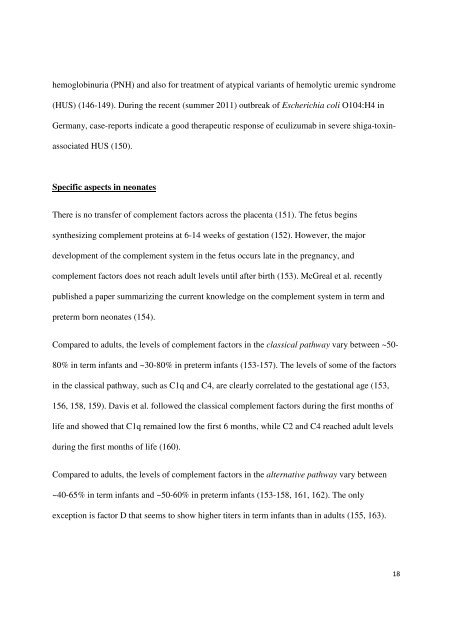Staphylococcus epidermidis - virulence factors and innate ... - Munin
Staphylococcus epidermidis - virulence factors and innate ... - Munin
Staphylococcus epidermidis - virulence factors and innate ... - Munin
Create successful ePaper yourself
Turn your PDF publications into a flip-book with our unique Google optimized e-Paper software.
hemoglobinuria (PNH) <strong>and</strong> also for treatment of atypical variants of hemolytic uremic syndrome<br />
(HUS) (146-149). During the recent (summer 2011) outbreak of Escherichia coli O104:H4 in<br />
Germany, case-reports indicate a good therapeutic response of eculizumab in severe shiga-toxinassociated<br />
HUS (150).<br />
Specific aspects in neonates<br />
There is no transfer of complement <strong>factors</strong> across the placenta (151). The fetus begins<br />
synthesizing complement proteins at 6-14 weeks of gestation (152). However, the major<br />
development of the complement system in the fetus occurs late in the pregnancy, <strong>and</strong><br />
complement <strong>factors</strong> does not reach adult levels until after birth (153). McGreal et al. recently<br />
published a paper summarizing the current knowledge on the complement system in term <strong>and</strong><br />
preterm born neonates (154).<br />
Compared to adults, the levels of complement <strong>factors</strong> in the classical pathway vary between ~50-<br />
80% in term infants <strong>and</strong> ~30-80% in preterm infants (153-157). The levels of some of the <strong>factors</strong><br />
in the classical pathway, such as C1q <strong>and</strong> C4, are clearly correlated to the gestational age (153,<br />
156, 158, 159). Davis et al. followed the classical complement <strong>factors</strong> during the first months of<br />
life <strong>and</strong> showed that C1q remained low the first 6 months, while C2 <strong>and</strong> C4 reached adult levels<br />
during the first months of life (160).<br />
Compared to adults, the levels of complement <strong>factors</strong> in the alternative pathway vary between<br />
~40-65% in term infants <strong>and</strong> ~50-60% in preterm infants (153-158, 161, 162). The only<br />
exception is factor D that seems to show higher titers in term infants than in adults (155, 163).<br />
18
















